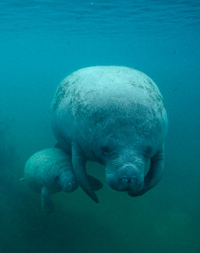 According to statistics released in January 2006, the year 2005 was the second deadliest on record for Florida's endangered manatee population. One of the leading causes of fatalities was the toxins produced by "red tide" blooms of the alga Karenia brevis, which appear to be growing increasingly common in Florida. A recently completed collaborative study now suggests a surprisingly tight connection between the effects of the toxins on manatees and on humans, and potential implications for human impacts.
According to statistics released in January 2006, the year 2005 was the second deadliest on record for Florida's endangered manatee population. One of the leading causes of fatalities was the toxins produced by "red tide" blooms of the alga Karenia brevis, which appear to be growing increasingly common in Florida. A recently completed collaborative study now suggests a surprisingly tight connection between the effects of the toxins on manatees and on humans, and potential implications for human impacts.
On Saturday, Feb. 18, Gregory Bossart, a marine mammal veterinarian and pathologist at the Harbor Branch Oceanographic Institution in Ft. Pierce, Fla., will discuss results of the study during a 9:00 a.m. Central Time press conference at the Annual Meeting of the American Association for the Advancement of Science, and in more detail at a scientific session later that day at 2:30 p.m. Central Time.
"It appears that these red tide events are increasing in nature, especially on Florida's west coast," says Bossart, who directs the Harbor Branch Marine Mammal Research and Conservation Division. "I think that manatees and other animals impacted by these events are sentinels for serious environmental and human problems, " he says, "and in fact our research makes a strong case for potentially severe human red tide impacts."
Hoping to determine if brevetoxins are having an impact on humans that parallels increasing threats to manatees, Bossart and colleagues began a National Institutes of Health (NIH)-funded 5-year study of the problem in 2000. The project included scientists from the University of North Carolina, Wilmington, the University of Miami in Florida, Mote Marine Laboratory in Sarasota, Fla., and the Lovelace Respiratory Research Institute in Albuquerque, N.M., as well as other scientists from Harbor Branch.
Researchers have been familiar with the human threats posed by brevetoxin-tainted shellfish, which can cause neurotoxic shellfish poisoning. The focus of the NIH project was instead the impacts of brevetoxin inhalation on humans , which were far less understood.
As one component of the work, the team reviewed records from the Florida Department of Health that showed the number of people in affected areas admitted to emergency rooms with respiratory problems such as bronchitis, or asthma flare ups, sharply increases during red tide blooms.
"What's disturbing," says Bossart, "is that humans appear to respond to prolonged brevtoxin exposure in a way similar to manatees that die from it."
To better understand those human effects, a key component of the NIH project was a study of the impacts of brevetoxin inhalation on mice. Interestingly, the researchers have not been able to mimic in mice the inhalation effects observed in humans and manatees, illustrating the tie between the health of both. However, the team did find that the toxins caused immune suppression in the mice, which suggests that the impacts of the red tide problem on manatees and humans may be more far-reaching than previously realized. If brevetoxins similarly suppress human and manatee immune systems, as Bossart believes is likely, then it could open those exposed to brevetoxins to ailments not currently associated with the red tides. This would pose a serious problem to residents of southwest Florida, where red tide events have been most severe, and also to a lesser extent people living at other areas around the Gulf of Mexico and Florida's Atlantic coast where red tides also occur.
Bossart believes that increasing brevetoxin woes for both manatees and humans are good examples of a problem he calls "environmental distress syndrome". The theory is that ecological and other changes associated with human activities are expanding the reach of existing disease threats in the marine environment and enabling the emergence of new disease-causing agents. Bossart and colleagues have, for example, recently documented a number of new viruses in dolphins and other marine mammals. In parallel, marine mammals may be becoming increasingly susceptible to these emerging and existing diseases as a result of poor environmental conditions causing such problems as degraded immune systems. Though the topic remains controversial, some scientists have suggested that red tide events are increasing as a result of human activities, namely increasing nutrient pollution through runoff and other problems that may fuel red tide growth.
Through earlier research, Bossart and colleagues developed the first sensitive test for the presence of brevetoxins in manatee tissue. This was a key advancement, as positive determination of toxin presence had remained an elusive goal. Relying partially on that test, an interdisciplinary group of researchers discovered recently that manatees can be killed not just by inhaling brevetoxins during a red tide bloom, but also by brevetoxins sequestered in seagrasses eaten long after a bloom has dissipated. These results, published in Nature in 2005, further strengthen the human-manatee tie on brevetoxin effects as humans also face serious health threats from brevetoxins sequestered in seafood.
Source : Harbor Branch Oceanographic Institution
 Print Article
Print Article Mail to a Friend
Mail to a Friend
